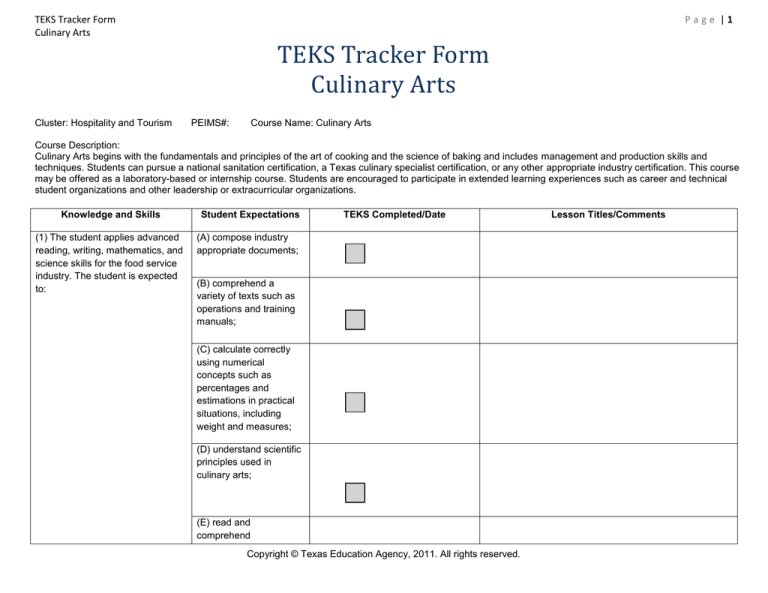
TEKS Tracker Form
Culinary Arts
Page |1
TEKS Tracker Form
Culinary Arts
Cluster: Hospitality and Tourism
PEIMS#:
Course Name: Culinary Arts
Course Description:
Culinary Arts begins with the fundamentals and principles of the art of cooking and the science of baking and includes management and production skills and
techniques. Students can pursue a national sanitation certification, a Texas culinary specialist certification, or any other appropriate industry certification. This course
may be offered as a laboratory-based or internship course. Students are encouraged to participate in extended learning experiences such as career and technical
student organizations and other leadership or extracurricular organizations.
Knowledge and Skills
Student Expectations
(1) The student applies advanced
reading, writing, mathematics, and
science skills for the food service
industry. The student is expected
to:
(A) compose industry
appropriate documents;
TEKS Completed/Date
(B) comprehend a
variety of texts such as
operations and training
manuals;
(C) calculate correctly
using numerical
concepts such as
percentages and
estimations in practical
situations, including
weight and measures;
(D) understand scientific
principles used in
culinary arts;
(E) read and
comprehend
Copyright © Texas Education Agency, 2011. All rights reserved.
Lesson Titles/Comments
TEKS Tracker Form
Culinary Arts
Page |2
standardized recipes;
(F) write and convert
standardized recipes;
and
(G) Calculate and
manage food costs.
(2) The student integrates
listening, writing, and speaking
skills using verbal and nonverbal
communication to enhance
operations, guest satisfaction, and
professional development. The
student is expected to:
(A) create formal or
informal presentations;
(B) properly answer
business phones;
(C) write instructions for
a specific restaurant or
culinary procedure or the
use of a piece of
equipment; and
(D) Attend and
participate in a staff
meeting.
(3) The student demonstrates an
understanding that personal
success depends on personal
effort. The student is expected to:
(A) demonstrate a
proactive understanding
of self-responsibility and
self-management;
Copyright © Texas Education Agency, 2011. All rights reserved.
TEKS Tracker Form
Culinary Arts
Page |3
(B) explain the
characteristics of
personal values and
principles;
\
(C) demonstrate positive
attitudes and work
habits;
(D) demonstrate
exemplary appearance
and personal hygiene;
and
(E) Evaluate the effects
of exercise and
nutritional dietary habits
and emotional factors
such as stress, fatigue,
or anxiety on job
performance.
(4) The student develops principles
in time management, decision
making, effective communication,
and prioritizing. The student is
expected to:
(A) apply effective
practices for managing
time and energy;
(B) analyze various
steps in the decisionmaking process; and
(C) Analyze the
importance of balancing
a career, family, and
leisure activities.
Copyright © Texas Education Agency, 2011. All rights reserved.
TEKS Tracker Form
Culinary Arts
(5) The student researches,
analyzes, and explores lifestyle
and career goals. The student
examines jobs available in the food
service industry and accesses
career opportunities. The student
is expected to:
Page |4
(A) research the major
job duties and
qualifications for all staff
and managerial
positions to facilitate
selection of career
choices in culinary arts;
(B) update a personal
career portfolio;
(C) demonstrate proper
interview techniques;
(D) establish personal
short-term and long-term
goals; and
(E) Examine food
service related
community service
opportunities.
(6) The student understands the
history of food service and the use
of the professional kitchen. The
student is expected to:
(A) research famous chefs
from history and note their
major accomplishments;
(B) identify global
cultures and traditions
related to food;
Copyright © Texas Education Agency, 2011. All rights reserved.
TEKS Tracker Form
Culinary Arts
Page |5
(C) summarize historical
entrepreneurs who
influenced food service
in the United States;
(D) analyze how current
trends in society affect
the food service
industry;
(E) use large and small
equipment in a
commercial kitchen;
(F) develop food
production and
presentation techniques;
(G) demonstrate moist
and dry cookery
methods;
(H) demonstrate the
preparation skills of
items commonly
prepared in food service
operations such as
breakfast cookery,
salads and dressings,
soups and sandwiches,
stocks and sauces,
appetizers, seafood,
poultry, meat, pastas
and grains, and fruits
and vegetables;
(I) demonstrate baking
techniques such as
Copyright © Texas Education Agency, 2011. All rights reserved.
TEKS Tracker Form
Culinary Arts
Page |6
yeast breads and rolls,
quick breads, and
desserts;
(J) demonstrate proper
receiving and storage
techniques;
(K) demonstrate proper
cleaning of equipment
and maintenance of the
commercial kitchen; and
\
(L) Demonstrate types of
table setting, dining, and
service skills.
Copyright © Texas Education Agency, 2011. All rights reserved.








